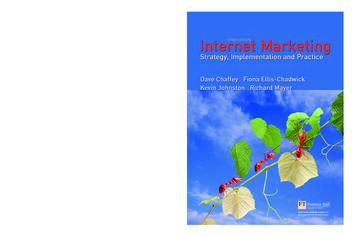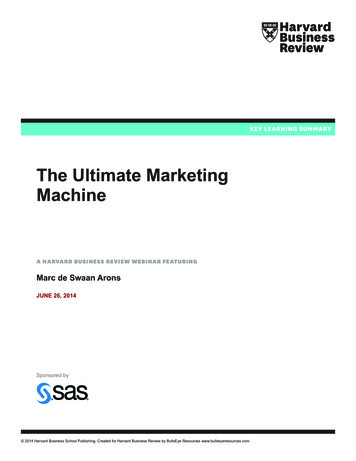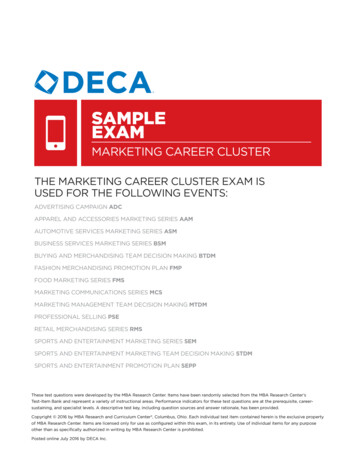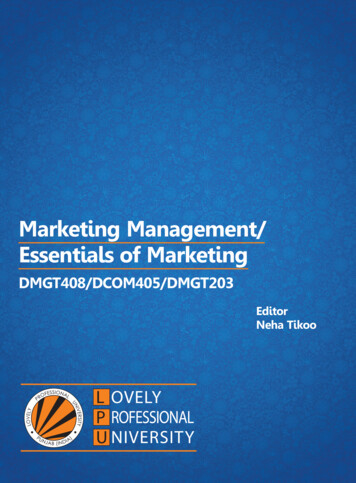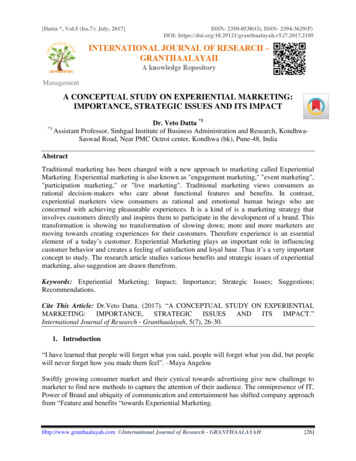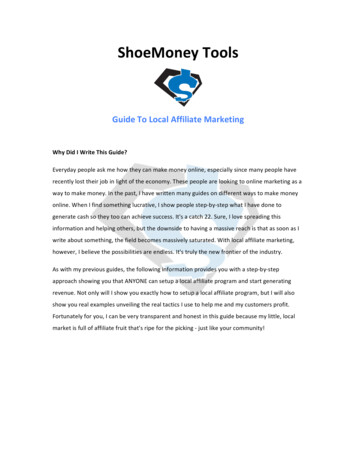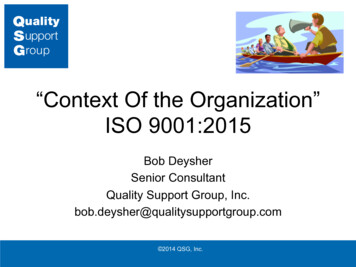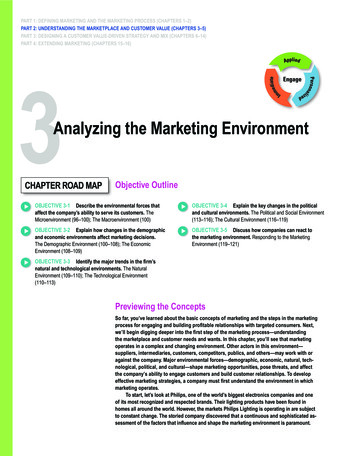
Transcription
Part 1: Defining Marketing anD the Marketing Process (chaPters 1–2)Part 2: UnDerstanDing the MarketPlace anD cUstoMer ValUe (chaPters 3–5)Part 3: Designing a cUstoMer ValUe-DriVen strategy anD Mix (chaPters 6–14)Part 4: extenDing Marketing (chaPters 15–16)3analyzing the Marketing environmentchaPter roaD MaPobjective outlineobjectiVe 3-1 Describe the environmental forces thatobjectiVe 3-4 explain the key changes in the politicalobjectiVe 3-2 explain how changes in the demographicobjectiVe 3-5 Discuss how companies can react toaffect the company’s ability to serve its customers. TheMicroenvironment (96–100); The Macroenvironment (100)and economic environments affect marketing decisions.The Demographic Environment (100–108); The EconomicEnvironment (108–109)and cultural environments. The Political and Social Environment(113–116); The Cultural Environment (116–119)the marketing environment. Responding to the MarketingEnvironment (119–121)objectiVe 3-3 identify the major trends in the firm’snatural and technological environments. The NaturalEnvironment (109–110); The Technological Environment(110–113)Previewing the conceptsso far, you’ve learned about the basic concepts of marketing and the steps in the marketingprocess for engaging and building profitable relationships with targeted consumers. next,we’ll begin digging deeper into the first step of the marketing process—understandingthe marketplace and customer needs and wants. in this chapter, you’ll see that marketingoperates in a complex and changing environment. other actors in this environment—suppliers, intermediaries, customers, competitors, publics, and others—may work with oragainst the company. Major environmental forces—demographic, economic, natural, technological, political, and cultural—shape marketing opportunities, pose threats, and affectthe company’s ability to engage customers and build customer relationships. to developeffective marketing strategies, a company must first understand the environment in whichmarketing operates.to start, let’s look at Philips, one of the world’s biggest electronics companies and oneof its most recognized and respected brands. their lighting products have been found inhomes all around the world. however, the markets Philips lighting is operating in are subjectto constant change. the storied company discovered that a continuous and sophisticated assessment of the factors that influence and shape the marketing environment is paramount.
first stopPhilips: Analyzing the Marketing Environment inthe Middle EastKoninklijke Philips N.V. was founded by Anton and Gerard Philips in 1891 in Eindhoven to manufacture carbonfilament lamps. Among their first major clients were earlyelectricity companies, who included the provision of lampsin their power supply contracts. The company, now betterknown simply as Philips, is one of the world’s biggest electronics companies and one of the world’s most respectedbrands. It has evolved into a global player and today employs a workforce of 113,687 around the world. A marketleader in medical diagnostic imaging, patient monitoringsystems, energy-efficient lighting, and lifestyle solutionsfor personal well-being, Philips manufactures more thanPhilips’s analysis of market needs—such as demands for energy-efficient50,000 products across 100 countries, in which it also op- products like leDs—has driven its continuous growth in this region.erates sales and service outlets. In 2014, the firm reported Hal P/Shutterstocksales of 23,982 billion. But Philips has also stayed true toits roots—today, it is the world leader in lighting products manufacturing.On September 23, 2014, Philips announced that it would sepaThe first objective was to select the most attractive marketsrate its healthcare and lighting businesses into two new companiesin the region. Over the years, Philips has developed a statisticalin order to better tailor its offerings to the specific customer segmentsmodel that displays a correlation between a country’s demand forand leverage the Philips brand. Giving independence to the lightinglighting and its GDP per capita. The company has identified thissolutions business, Philips claims, would better enable it to expandcorrelation after careful analysis of GDP growth rate data and theirits global leadership position and venture into adjacent market opporcorresponding sales figures. During discussions with agents andtunities. Both companies are supposed to be able to make the approdistributors in many countries, Philips was completely dependentpriate investments to boost growth and drive profitability, ultimatelyon its information about the market size. If Philips miscalculatedgenerating significantly more value for their customers, employees,market size, it missed market opportunities. The key reason whyand shareholders.this model was developed was so that theSince the 1980s, Philips has participated intensively in thecompany could cross-check marketconcentration of the lighting sector by purchasing smaller naestimations of its agents andtional companies such as Companie des Lampes (France), AEGdistributors. The developed(Germany), and Polam Pila (Poland). It has also developed differmodel showed that the dePhilips lighting isent joint ventures, with, for example, Westinghouse Lamps, Konomand for lamps and bulbsno. 1 in the world marketSylvania, and EBT China. Today, Philips Lighting is no. 1 in theis a basic need for afor lighting, but as the marketingworld market for lighting, ahead of competitors like Osram, Halocountry, and as soon asenvironment constantly changes,nix, and Crompton. Their lighting products (light bulbs and lamps)a country starts develPhilips has realized that assessingare found all around the world, not only everywhere at home,oping (which is indicatedmultiple factors for change is vitalbut also in many professional applications, including 30 percentby the increase in GDP),to the understanding of currentof offices, 65 percent of the world’s top airports, 30 percent ofthis basic need increases.and probable future shifts.hospitals, 35 percent of cars, and 55 percent of major footballHowever, as the country’sstadiums.wealth increases, the growthFor 124 years, Philips has been a leader in building and shapingin the demand slows down,markets with meaningful innovations including the radio, audio casbecause basic lighting needs aresette, video cassette recorder (VCR), compact disc (CD), and digitalcovered at later stages of economic deversatile disc (DVD). In order to succeed in its markets, Philips mustvelopment.carefully and continuously analyze the marketing environment. AtIn order to find the most attractive markets, Philips Lighting usedthe beginning of the twenty-first century, Philips needed a new andthe model and combined it with market data of the Middle East thatcoherent marketing strategy for the entire Middle East region, whichcontained population, GNP growth, and GNP per capita. They multihad been identified as one of the key markets by the company. Inplied the demand for lighting per capita by the number of inhabitantsorder to better address macroeconomic factors and regional preferin a country. Looking at the regions, Israel and Kuwait had the highences, Philips wanted to develop a more integrated and less fragest GDP per capita, but their population size was rather small. Onmented marketing strategy for the region.the other hand, Iraq and Iran were (and still are) large markets for95
lighting, but they are very tough to enter because of their politicallydifficult situations.However, the Philips Lighting Middle East managers did not usemarket size as the only selection criterion for priority; instead, themodel was used as a starting point for discussions with agents anddistributors in the respective countries. If the Philips sales in largelighting markets were very low, this would indicate a low Philips market share. This would lead to a discussion with local agents and distributors about how to increase the regional Philips market shares incooperation with the local distributor.Today, the lighting market is impacted by multiple factors, threeof which are particularly important. The first is the macroeconomicsituation, which is influenced and shaped by factors such as inflation rate and GDP, and which is influencing new construction and,consequently, the number of lighting installations. This key driverwas used as a main indicator by Philips in its model to screenmarkets in the Middle East. Another important element used was,and still is, country-specific energy efficiency regulations and anincrease in energy awareness, which are redefining future light-Marketing environmentThe actors and forces outside marketingthat affect marketing management’sability to build and maintain successfulrelationships with target customers.MicroenvironmentThe actors close to the company thataffect its ability to engage and serve itscustomers—the company, suppliers,marketing intermediaries, customermarkets, competitors, and publics.MacroenvironmentThe larger societal forces that affect themicroenvironment—demographic,economic, natural, technological,political, and cultural forces.author commentThe microenvironment includes all the actorsclose to the company that affect, positively ornegatively, its ability to create value for andrelationships with customers.ing product portfolios. For example, in 2014 the UAE governmentannounced an energy efficiency regulation on lighting productsthat bans the sale of inefficient standard bulbs while also seekingto reduce carbon dioxide emissions. Government action limitingcertain energy sources—especially nuclear power due to eventsover the last years—results in additional demands for energy-efficient products such as LEDs. For example, Dubai’s governmenthas started an initiative in 2014 to switch all lighting in government buildings to LED, which is more energy-efficient and can bedigitally controlled. It is these projects that have helped Philips togrow in the region.Philips has managed to assess these factors, which heavilyinfluence and shape the marketing environment, for change. Thecompany’s capability in understanding current and probable future shifts in the lighting market has driven its continuous growthin this region, making it the market leader in Middle Eastern countries such as the Emirates, where it has a 38.5 percent marketshare; trailed by Osram, with 22.6 percent; and General Electric,with 16.3 percent.1company’s marketing environment consists of the actors and forces outsidemarketing that affect marketing management’s ability to build and maintain successful relationships with target customers. Like Philips, companies must constantlywatch and adapt to the changing environment—or, in many cases, lead those changes.More than any other group in the company, marketers must be environmental trendtrackers and opportunity seekers. Although every manager in an organization should watchthe outside environment, marketers have two special aptitudes. They have disciplinedmethods—marketing research and marketing intelligence—for collecting informationand developing insights about the marketing environment. They also spend more time incustomer and competitor environments. By carefully studying the environment, marketerscan adapt their strategies to meet new marketplace challenges and opportunities.The marketing environment consists of a microenvironment and a macroenvironment.The microenvironment consists of the actors close to the company that affect its ability to engage and serve its customers—the company, suppliers, marketing intermediaries,customer markets, competitors, and publics. The macroenvironment consists of the largersocietal forces that affect the microenvironment—demographic, economic, natural, technological, political, and cultural forces. We look first at the company’s microenvironment.athe MicroenvironmentMarketing management’s job is to build relationships with customers by creating customervalue and satisfaction. However, marketing managers cannot do this alone. figure 3.1shows the major actors in the marketer’s microenvironment. Marketing success requiresbuilding relationships with other company departments, suppliers, marketing intermediaries, competitors, various publics, and customers, which combine to make up thecompany’s value delivery network.the companyIn designing marketing plans, marketing management takes other company groups intoaccount—groups such as top management, finance, research and development (R&D),purchasing, operations, human resources, and accounting. All of these interrelated groups96
chapter 3: analyzing the Marketing environment97figure 3.1 actors in the Microenvironment/CTMGVKPIGTU UVQO%W6JG EQORCP[ 2WD /CTMGVGTU OWUV YQTMKP JCTOQP[ YKVJ QVJGTEQORCP[ FGRCTVOGPVUVQ ETGCVG EWUVQOGTXCNWG CPF TGNCVKQPUJKRU TUNKG %QORGMGVKPIVKVQT/CT FKCTKGU UGOTGVP KUNKE5WRR P ETGCVKPI XCNWG HQT EWUVQOGTU OCTMGVGTU OWUV RCTVPGT YKVJQVJGT ƂTOU KP VJG EQORCP[oUXCNWG FGNKXGT[ PGVYQTM %WUVQOGTU CTG VJG OQUVKORQTVCPV CEVQTU KP VJGEQORCP[oU OKETQGPXKTQPOGPV 6JG CKO QH VJG GPVKTG XCNWGFGNKXGT[ U[UVGO KU VQ UGTXGVCTIGV EWUVQOGTU CPF ETGCVGUVTQPI TGNCVKQPUJKRU YKVJ VJGO form the internal environment. Top management sets the company’s mission, objectives, broad strategies, and policies. Marketing managers make decisions within thesebroader strategies and plans. Then, as we discussed in Chapter 2, marketing managersmust work closely with other company departments. With marketing taking the lead, alldepartments—from manufacturing and finance to legal and human resources—share theresponsibility for understanding customer needs and creating customer value.suppliersSuppliers form an important link in the company’s overall customer value delivery network. They provide the resources needed by the company to produce its goods and services. Supplier problems can seriously affect marketing. Marketing managers must watchsupply availability and costs. Supply shortages or delays, natural disasters, and otherevents can cost sales in the short run and damage customer satisfaction in the long run.Rising supply costs may force price increases that can harm the company’s sales volume.Most marketers today treat their suppliers as partners in creating and delivering customer value. For example, Honda knows the importance of building close relationshipswith its extensive network of suppliers, who furnish everything from fuel tanks, brakecontrols, and seating systems to production equipment and office supplies.2In the United States alone, American Honda purchases 23 billion worth of auto parts andmaterials annually from 530 strategic suppliers in 34 states. It spends billions of dollars more onmaintenance, repair, and operations (MRO) supplies and services from another 13,900 suppliers.Outside purchases represent about 75 percent of the cost of making a Honda vehicle. So Hondaviews strategic suppliers as key players in its success and develops deep relationships and teamwork with them. “These suppliersare literally considered extensions of Honda,” says one insider.For example, Honda requires that strategic suppliers openup their books and give Honda full access to their financialinformation. This helps Honda purchasing associates, Hondaengineers, and supplier engineers work as a team to achievetarget costs and quality standards, often improving suppliers’ performance and profit margins in the process. Supplierpersonnel also participate in Honda training programs onleadership, finance, quality, and other topics. And Honda meetsformally each year with strategic suppliers to review the previous year’s results and set goals for the coming year. As a resultof such teamwork, Honda has developed healthy, long-termsupplier relationships. “Almost 100 percent of the originalsuppliers: through close teamwork, honda has developed healthy,suppliers selected in the late 1980s are still Honda supplierslong-term supplier relationships. strategic suppliers are considered extensionstoday,” says the insider. In a recent industry survey, automotiveof honda, to the benefit of both partners.suppliers rated Honda the “most preferred” customer amongthe world’s top six auto manufacturers.(right) Ian Dagnall/Alamy Stock Photo (left) Bloomberg via Getty Images
98Part 2: Understanding the Marketplace and customer ValueMarketing intermediariesMarketing intermediariesFirms that help the company topromote, sell, and distribute itsproducts to final buyers.Marketing intermediaries help the company promote, sell, and distribute its products tofinal buyers. They include resellers, physical distribution firms, marketing services agencies, and financial intermediaries. Resellers are distribution channel firms that help thecompany find customers or make sales to them. These include wholesalers and retailersthat buy and resell merchandise. Selecting and partnering with resellers is not easy. Nolonger do manufacturers have many small, independent resellers from which to choose.They now face large and growing reseller organizations, such as Walmart, Target, HomeDepot, Costco, and Best Buy. These organizations frequently have enough power to dictate terms or even shut smaller manufacturers out of large markets.Physical distribution firms help the company stock and move goods from their pointsof origin to their destinations. Marketing services agencies are the marketing researchfirms, advertising agencies, media firms, and marketing consulting firms that help the company target and promote its products to the right markets. Financial intermediaries includebanks, credit companies, insurance companies, and other businesses that help finance transactions or insure against the risks associated with the buying and selling of goods.Like suppliers, marketing intermediaries form an important component of the company’s overall value delivery network. In its quest to create satisfying customer relationships,the company must do more than just optimize its own performance. It must partnereffectively with marketing intermediaries to optimize the performance of the entire system.Thus, today’s marketers recognize the importance of working with their intermediaries aspartners rather than simply as channels through which they sell their products. For example,when Coca-Cola signs on as the exclusive beverage provider for a fast-food chain, such asMcDonald’s, Wendy’s, or Subway, it provides much more thanjust soft drinks. It also pledges powerful marketing support:3Partnering with intermediaries: coca-cola provides its retail partnerswith much more than just soft drinks. it also pledges powerful marketingsupport.Bloomberg via Getty ImagesCoca-Cola assigns cross-functional teams dedicated to understanding the finer points of each retail partner’s business. Itconducts a staggering amount of research on beverage consumers and shares these insights with its partners. It analyzes thedemographics of U.S. zip code areas and helps partners determine which Coke brands are preferred in their areas. Coca-Colahas even studied the design of drive-through menu boards tobetter understand which layouts, fonts, letter sizes, colors, andvisuals induce consumers to order more food and drink. Basedon such insights, the Coca-Cola Foodservice group developsmarketing programs and merchandising tools that help its retailpartners improve their beverage sales and profits. Its Web site,www.CokeSolutions.com, provides retailers with a wealth ofinformation, business solutions, merchandising tips, advice ondigital and social media marketing, and techniques on how to gogreen. “At Coca-Cola we always strive to be our customers’ mostvalued partner,” says Coca-Cola’s vice president of FoodserviceCustomer Marketing. Such intense partnering has made CocaCola a runaway leader in the U.S. fountain-soft-drink market.competitorsThe marketing concept states that, to be successful, a company must provide greater customer value and
coherent marketing strategy for the entire Middle East region, which had been identified as one of the key markets by the company. In order to better address macroeconomic factors and regional prefer-ences, Philips wanted to develop a more integrated and less frag-mented market


